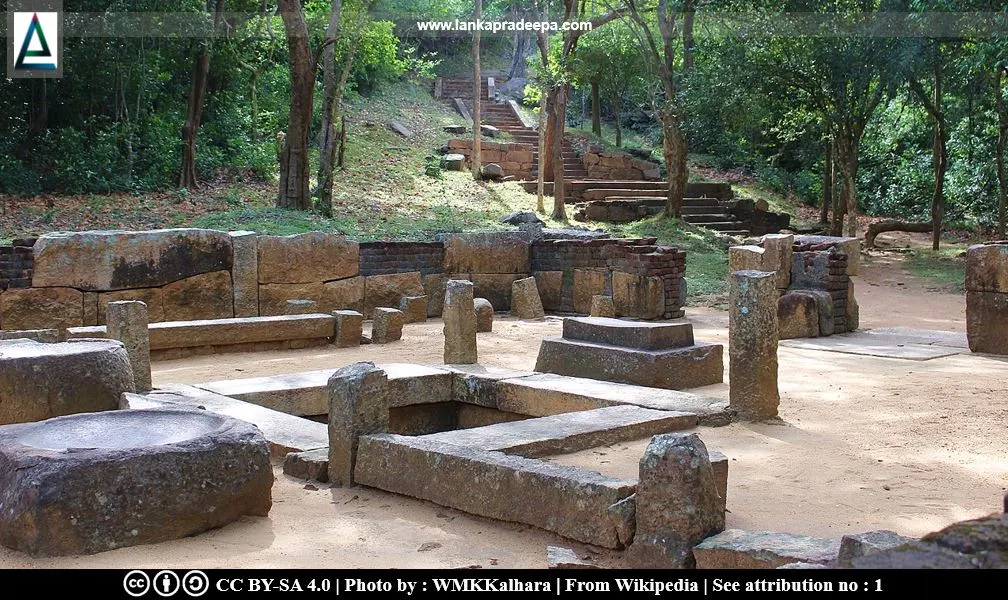
|
Manakanda Archaeological Site |
Manakanda Archaeological Site & the Eco-Park also known as Manewakanda Forest Reserve (Sinhala: මානෑවකන්ද) is situated in Ipalogama DS Division in Anuradhapura District, Sri Lanka. The site can be reached by travelling through the A-9 road from Kekirawa to Mihintale and taking a turn off to the site from Maradankadawala town.
Manewa Kanda Forest Reserve
Manewakanda is an isolated hill 378 m (1,240.16 ft. amsl) in height and its forest spreads of about 325 ha. (UNDP, 2015). The upper parts of this hill forest represent MMEF (Moist Mixed Evergreen Forest) environment (UNDP, 2015). The area receives an average annual precipitation of about 1,000-1,500 mm (Perera, 2012).
The forest falls under the jurisdiction of the Forest Department. Several popular tourist attractions in the area such as Avukana, Kala Wewa, Vijithapura, Anuradhapura, Mihintale, Nachchaduwa Wewa, Ritigala, Sigiriya, and Dambulla are located in the vicinity of this forest.
Manakanda Archaeological Site
Ruined monuments of an ancient Buddhist monastery are found on the eastern slopes of the Manewakanda (Wikramagamage, 2004). They include a Janthaghara, image house, flight of steps, Bodhighara, Padhanaghara, mounds of Stupas, ponds and other monuments. Of these ruins, the buildings known as Padhanaghara are considered an important feature of this site.
Padhanaghara
Padhanaghara, also known as Patanagala or Piyangala, is a special type of monastery built for the Bhikkhus (Buddhist monks) who devoted themselves to meditation involving minimum comforts. They are usually constructed in places situated outside the main areas of monastic and secular buildings. During the latter part of the Anuradhapura Period, Padhanagharas became popular and developed into large-scale complexes. Examples of this type of monasteries are found at the places such as Arankele, Ritigala, Nuvaragalkanda, Veherabendigala, and Western Monasteries etc. (Bandaranayake, 1990).


Related Posts
Read Also
References
Books, Journal Articles
1) Bandaranayake, S., 1990. The architecture of the Anuradhapura Period 543 B.C.-800 A.D. [Wijesekara, N. (Editor in chief)]. Archaeological Department centenary (1890-1990): Commemorative series: Volume III: Architecture. Department of Archaeology (Sri Lanka). pp.22-24.
2) Perera, G.A.D., 2012. Ecology of Sri Lankan Dry Forests: Implications for the Conservation Management of Northernmost Dry Forests. In Proceedings of Jaffna University International Research Conference (JUICE-2012) pp. 263-269.
3) UNDP, 2015. Enhancing Biodiversity Conservation and Sustenance of Ecosystem services in Environmentally Sensitive Areas. Project document. United Nations Development Programme (Sri Lanka). p.104.
4) Wikramagamage, C., 2004. Heritage of Rajarata: Major natural, cultural and historic sites. Colombo. Central Bank of Sri Lanka. p.39.
Location Map
Dynamic Google Map
Attribution
To Whom
1) Manawakanda Eco-park 04 by WMKKalhara is licensed under CC BY-SA 4.0
2) Manawakanda Eco-park 01 by WMKKalhara is licensed under CC BY-SA 4.0
LankaPradeepa.com extends its gratitude to Malsha M. Ranasinghe for providing the necessary photographs required for this article. All the photos are published here with the permission of the author.

